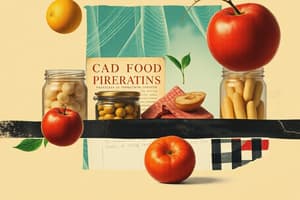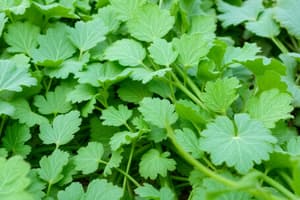Podcast
Questions and Answers
What is the primary purpose of blanching in food processing?
What is the primary purpose of blanching in food processing?
- To add flavor to vegetables
- To inactivate natural enzymes that cause discoloration and off-flavors and aromas (correct)
- To remove harsh flavors from vegetables
- To reduce the nutritional value of vegetables
What is the ideal temperature for blanching vegetables in hot water?
What is the ideal temperature for blanching vegetables in hot water?
- 95°C (203°F)
- 80°C (176°F)
- 88°C (190°F) (correct)
- 100°C (212°F)
What is the result of removing water from vegetables during dehydration?
What is the result of removing water from vegetables during dehydration?
- Reduced volume and weight (correct)
- Increased moisture content
- Reduced nutritional value
- Increased volume and weight
What is the purpose of rapid cooling after blanching?
What is the purpose of rapid cooling after blanching?
Which of the following is NOT a method of dehydrating vegetables?
Which of the following is NOT a method of dehydrating vegetables?
What is a common practice for roots and legumes after harvesting?
What is a common practice for roots and legumes after harvesting?
What is the effect of blanching on microorganisms in vegetables?
What is the effect of blanching on microorganisms in vegetables?
Why are treatments necessary for some vegetables?
Why are treatments necessary for some vegetables?
What is the purpose of washing and waxing some vegetables?
What is the purpose of washing and waxing some vegetables?
What is the benefit of modified-atmosphere packaging?
What is the benefit of modified-atmosphere packaging?
What is the atmosphere composition in modified-atmosphere packaging?
What is the atmosphere composition in modified-atmosphere packaging?
What is the purpose of vacuum packing and modified-atmosphere packaging?
What is the purpose of vacuum packing and modified-atmosphere packaging?
What treatment helps to preserve the texture of potatoes during the reconstitution process?
What treatment helps to preserve the texture of potatoes during the reconstitution process?
What is the primary function of sulfite in dehydrating potatoes?
What is the primary function of sulfite in dehydrating potatoes?
Why is canning a suitable method for food preservation in developing countries?
Why is canning a suitable method for food preservation in developing countries?
What happens to the containers during the canning process?
What happens to the containers during the canning process?
What is the main purpose of the heat treatment during canning?
What is the main purpose of the heat treatment during canning?
Why is the industry searching for sulfite replacements?
Why is the industry searching for sulfite replacements?
What is a limitation of freeze-drying in vegetable products?
What is a limitation of freeze-drying in vegetable products?
What is a characteristic of dehydrated potato granules?
What is a characteristic of dehydrated potato granules?
What is the purpose of air-lift drying in dehydrated potato granules production?
What is the purpose of air-lift drying in dehydrated potato granules production?
What is the difference between dehydrated potato flakes and granules?
What is the difference between dehydrated potato flakes and granules?
What is used to dry dehydrated potato flakes to final moisture content?
What is used to dry dehydrated potato flakes to final moisture content?
What is the texture of mashed potatoes made from dehydrated potato flakes?
What is the texture of mashed potatoes made from dehydrated potato flakes?
What is a possible cause of bulged cans after long periods of storage?
What is a possible cause of bulged cans after long periods of storage?
What is the nutrient most susceptible to destruction in canning?
What is the nutrient most susceptible to destruction in canning?
What is the process of aseptic canning also known as?
What is the process of aseptic canning also known as?
What is a characteristic of frozen foods?
What is a characteristic of frozen foods?
What is a possible consequence of consuming canned vegetables with bulged cans?
What is a possible consequence of consuming canned vegetables with bulged cans?
Why may some canned vegetables have inferior quality and less nutritive value?
Why may some canned vegetables have inferior quality and less nutritive value?
Flashcards are hidden until you start studying
Study Notes
Dehydration
- Freeze-drying produces high-quality food, but it is costly and rarely used for vegetables
- Dehydration is an old method of preserving food, removing water to reduce volume and weight, and aiding storage and transportation
Potato Products
- Instant potatoes are a common dehydrated product, used in restaurants and institutions
- Dehydrated potato granules have high bulk density, easy to handle, but produce mashed potatoes with a pasty texture
- Dehydrated flakes, on the other hand, produce mashed potatoes with a mealy texture, comparable to freshly prepared mashed potatoes
- Air-lift drying is used for granules, while steam-heated drum drying is used for flakes
Processing Vegetables
- Harvesting roots and legumes often involves machine-based harvesting, with some sorting and grading in the field or at collection stations
- Bulking is common, with few additional preparation steps before distribution
- Treatments may be necessary to prevent microbial spoilage, insects, and small animal invasion
- Washing, sorting, grading, cutting, and packaging into retail-size containers are steps taken for convenient foods
Blanching
- Blanching involves heating vegetables in hot water or steam to inactivate natural enzymes, reduce microorganisms, and make them limp for easy packing
- Blanching also serves to remove harsh flavors in some vegetables
Dehydration Methods
- Many machines are available for dehydration, including tunnel drying, vacuum drying, drum drying, spray drying, and freeze drying
Canning
- Canning is a major food-processing method, particularly useful in developing countries where refrigeration is limited
- Properly processed canned vegetables can be stored at room temperature for years
- Aseptic canning, or high-temperature–short-time (HTST) processing, is a superior method that avoids slow heat penetration and produces high-quality products
Studying That Suits You
Use AI to generate personalized quizzes and flashcards to suit your learning preferences.




